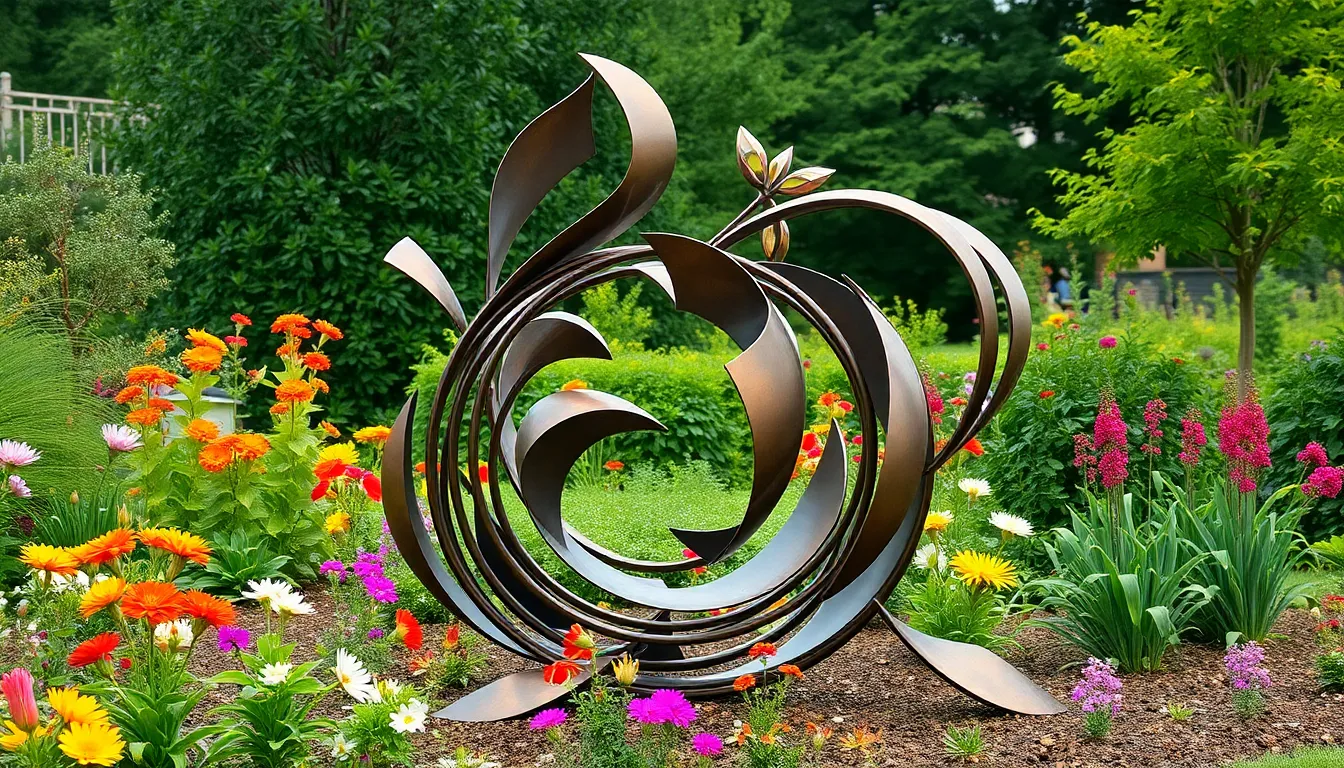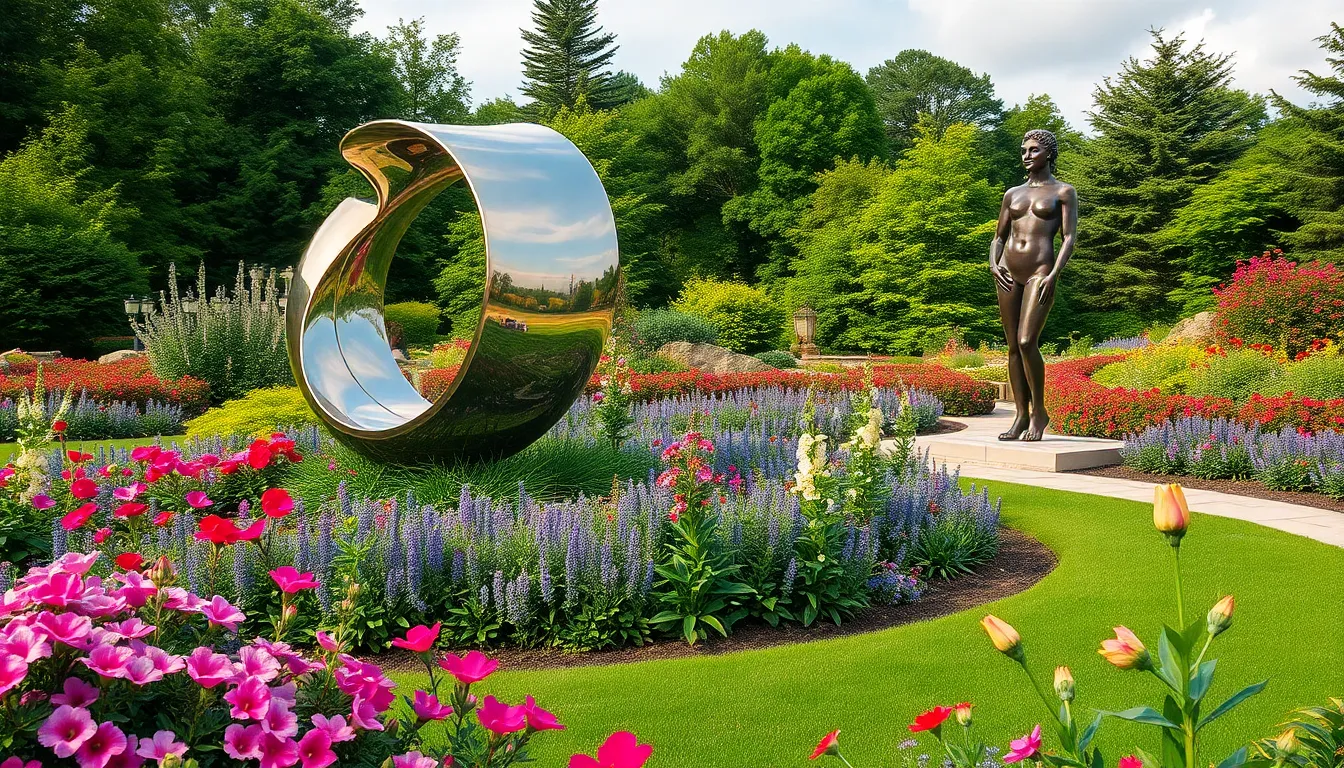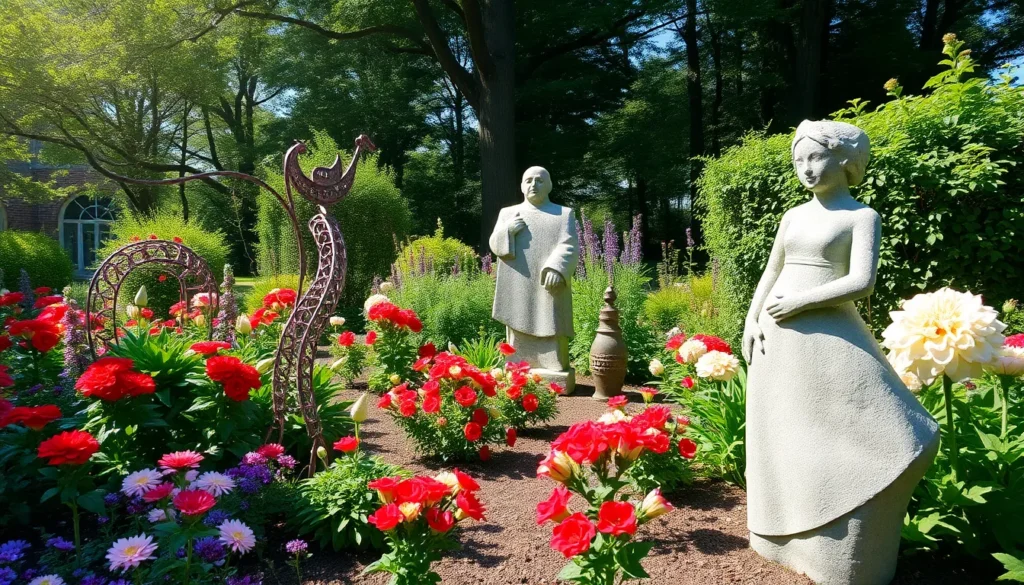Table of Contents
ToggleGarden sculptures transform outdoor spaces into captivating art galleries. These striking pieces add personality and charm, turning a simple garden into a vibrant sanctuary. From whimsical creatures to elegant abstracts, there’s a garden sculpture to suit every style and preference.
Incorporating sculptures into landscaping not only enhances visual appeal but also creates focal points that draw the eye. They invite curiosity and encourage visitors to explore the beauty of nature intertwined with artistry. Whether crafted from stone, metal, or recycled materials, garden sculptures can reflect the owner’s taste and passion for creativity. As outdoor spaces become extensions of our homes, the right sculpture can elevate a garden from ordinary to extraordinary.
Overview Of Garden Sculpture
Garden sculptures enhance outdoor spaces, serving as striking visual elements. These artistic pieces range from abstract forms to realistic depictions, appealing to various aesthetic preferences and garden themes. Whether crafted from stone, metal, or wood, each material type offers unique advantages and effects, influencing the overall ambiance.
Selecting garden sculptures involves consideration of scale, style, and placement. Large sculptures can dominate a landscape, while smaller pieces may accentuate specific areas. Curves, angles, and textures contribute significantly to how sculptures interact with light and nature, creating dynamic sightlines throughout the day.
Incorporating sculptures fosters an inviting environment, encouraging exploration and reflection. Focal points attract attention and guide visitors through gardens, enhancing engagement with the surrounding landscape. Artful selection supports personal expression, making gardens extensions of individual identity.
The choice of sculptures impacts maintenance and durability. Weather-resistant materials ensure longevity, reducing upkeep and preserving artistic integrity. Regular inspection prevents issues like rust on metal or cracking in stone, maintaining the sculpture’s intended beauty.
Innovative designs, such as kinetic or interactive sculptures, add layers of excitement, allowing for unique visitor experiences. These artistic features encourage personal interaction, evolving the relationship between art and observer. This aspect significantly contributes to the joy and uniqueness of garden spaces.
Types Of Garden Sculpture


Various types of garden sculptures exist, each serving to enhance specific themes, styles, and aesthetics within outdoor spaces. Primarily, they include abstract sculptures and figurative sculptures.
Abstract Sculptures
Abstract sculptures feature non-representational designs, focusing on form, color, and texture rather than specific objects or figures. These pieces create a sense of movement and interpretation, inviting viewers to engage their imagination. Materials such as metal, glass, stone, and resin commonly compose them, contributing to diverse finishes and styles. Placement of abstract sculptures can draw attention to particular areas of the garden, facilitating dynamic visual experiences and interactions with surrounding flora.
Figurative Sculptures
Figurative sculptures depict recognizable subjects, ranging from human figures to animals and mythological beings. These pieces often evoke emotion and storytelling, enhancing the garden’s narrative and ambiance. Crafted from materials including bronze, stone, ceramic, and wood, figurative sculptures can represent cultural, historical, or personal themes. Strategic placement of these sculptures around pathways or entry points encourages exploration and contemplation, creating inviting focal points that guide visitors through the outdoor space.
Materials Used In Garden Sculpture
Garden sculptures utilize a variety of materials, each offering unique aesthetic qualities and durability characteristics. Choosing the right material influences both the design and longevity of the sculptures.
Stone Sculptures
Stone sculptures often feature materials like limestone, granite, and marble. These materials provide durability and an element of timelessness to garden spaces. Stone sculptures withstand harsh weather conditions, remain stable in various climates, and require minimal maintenance. Their natural textures and colors blend seamlessly with the garden environment, enhancing the organic feel of the landscape. Well-known stone sculptures include classic statues or abstract shapes, which serve as focal points in curated garden areas.
Metal Sculptures
Metal sculptures primarily use materials such as stainless steel, bronze, and aluminum. These metals offer contemporary appeal due to their sleek designs and ability to incorporate intricate details. Metal sculptures exhibit resistance to rust and corrosion when treated, making them suitable for outdoor settings. Artists often employ methods like welding and casting to create dramatic forms that play with light and movement. Sculptures may feature polished finishes that reflect sunlight or patinas that transform over time, adding to their visual interest and allure.
Wood Sculptures
Wood sculptures utilize materials like cedar, teak, and oak. These materials showcase warmth and natural aesthetic, often lending an organic touch to garden spaces. Although wood requires regular maintenance and protective treatments to ensure longevity, it allows for a range of artistic expression through carving and shaping. Artists can create intricate designs that highlight the grain and texture of the wood, marrying art with nature. Over time, wooden sculptures can develop a beautiful patina, enriching their visual character while blending harmoniously within the garden context.
Importance Of Garden Sculpture
Garden sculptures play a crucial role in transforming outdoor spaces into artistic showcases that enhance overall aesthetics. Sculptures add personality, charm, and character to gardens, providing visual focal points that invite exploration. Their diverse styles, from whimsical to elegant, cater to various tastes and design philosophies.
The choice of sculpture impacts a garden’s atmosphere significantly. Large pieces command attention, creating dramatic statements, while smaller sculptures can accentuate specific areas, adding depth and interest. Properly placed sculptures interact with natural light and surroundings, creating dynamic sightlines that shift throughout the day, thus enhancing visual engagement.
Materials used for sculptures contribute to their importance as well. Weather-resistant options like stone, metal, and treated wood ensure longevity and minimize maintenance challenges. Durable sculptures maintain their artistic integrity over time, allowing them to remain vital components of the garden landscape.
Incorporating garden sculptures also enriches viewer experience. Sculptures encourage contemplation, interaction, and reflection, guiding visitors through the space and enhancing emotional connections to the environment. Unique designs, such as kinetic or interactive sculptures, foster personal engagement, further deepening the relationship between art and observer.
Lastly, the categorization of sculptures into abstract and figurative types impacts garden storytelling. Abstract sculptures emphasize form, color, and texture, inviting imaginative engagement. In contrast, figurative sculptures depict recognizable subjects, evoking emotions and enhancing narrative depth. Ultimately, garden sculptures serve as vital artistic expressions, elevating outdoor spaces and creating memorable experiences.
Care And Maintenance Of Garden Sculpture
Maintaining garden sculptures ensures their beauty and longevity. Regular upkeep prevents deterioration and preserves artistic integrity.
Cleaning Techniques
- Use mild soap: Apply a solution of mild soap and water, using a soft cloth or sponge for gentle cleaning.
- Avoid harsh chemicals: Steer clear of abrasive cleaners, as they can damage surfaces and finishes.
- Rinse thoroughly: Rinse off soap with clean water to prevent residue buildup.
Seasonal Considerations
- Inspect during spring: Check for any winter damage, such as cracks or discoloration, and address issues promptly.
- Winter preparation: For freeze-prone areas, consider moving sensitive sculptures indoors or applying protective covers.
- Monitor during summer: Assess for sun damage, which can fade colors and erode finishes over time.
Material-Specific Care
- Stone sculptures: Clean with water and a soft brush to avoid altering the surface texture. Seal with a stone-specific sealer every couple of years for added protection.
- Metal sculptures: Wipe off dirt and rust with a soft cloth. Apply a rust-resistant coating periodically to maintain integrity.
- Wood sculptures: Treat with a weather-resistant finish or sealant to prevent moisture damage and insect infestations.
Repair Strategies
- Fix minor cracks: Use an appropriate adhesive for the material type to repair small damages quickly.
- Restoration services: Seek professional assistance for extensive restoration, ensuring the work maintains the original artistry.
Environmental Awareness
- Consider placement: Avoid direct exposure to harsh elements like heavy winds, driving rain, or extreme heat by placing sculptures in sheltered areas.
- Plant selection: Surround sculptures with vegetation that does not overpower them, promoting visual balance without obstructing views.
Implementing these care and maintenance strategies keeps garden sculptures vibrant and integral parts of the landscape, enhancing the overall aesthetic experience.





